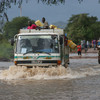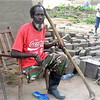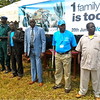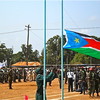Long drought forecast, late rains
Drought among other natural challenges is yet another issue the soon to be independent nation of Southern Sudan might have to face and find alternatives to. According to the World Meteorological Organisation (WMO), La Niña, the weather pattern associated with the cooling of the central and eastern Pacific Ocean every two to five years, is expected to cause widespread drought in Africa. The WMO is forecasting higher than average temperatures, with rains beginning as late as mid-May.

Drought-stricken vegetation near Juba.Other countries likely to experience the impacts of La Niña are Uganda, Djibouti, Ethiopia, Eritrea, Tanzania, Rwanda and Burundi. Kenya and Somalia have already been affected.
Meteorology Commissioner James Magezi-Akiiki at Uganda’s Ministry for Water and Environment said La Niña’s presence had been tracked since last July but went largely unnoticed.
Now the magnitude is likely to intensify,” he said, noting that officials are collaborating in an effort to avert or reduce the impacts of hotter weather, from food and water shortages to dying livestock.
IRIN on La Niña in East Africa
In contrast to its meteorological sibling” El Niño, which is characterised by unusually warm temperatures in the equatorial Pacific, La Niña triggers cooler ocean temperatures that ironically keep Africa hotter and drier than usual, a phenomenon that can lead to food emergencies costing millions of dollars.
Magezi-Akiiki attributes the harsher conditions to global climate change that could affect cattle corridors and residents whose livelihoods depend on subsistence farming in lowland areas.

Wild fires could result from long-term drought.Higher temperatures can also create a risk of wildfires in both urban and rural areas. Residents of temporal shelters made from reeds and grasses are advised to exercise extra caution and water conservation.
I am aware of this looming calamity,” said Janet Aya Alex, a legislative representative of South Sudan’s Central Equatorial State. Describing the regions around Kapoeta as vulnerable,” she recognised the government’s many challenges of disaster preparedness. The Ministries of Humanitarian Affairs and Agriculture must do something about it,” she said.
El Niño last affected Africa in October 2007. In Sudan, roads and bridges collapsed or were washed away, cutting off Juba’s main roads from other regions when the government was ill prepared to deal with such emergencies.
Given the lower water table around the River Nile and Lake Victoria, people are being urged to keep extra food stocks, money and water to cope with a scarcity of resources.




